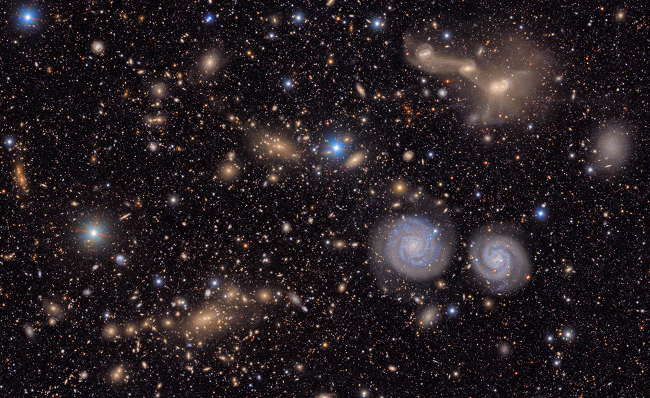Bob Siederer
30 June 2025

Hello again Science Fans!
I’ve been traveling a lot these past few months. It always brings me a fresh perspective, seeing other parts of the US and the world.
It also reminds me that no matter what you are going through, someone is worse off than you.
Today we celebrate the first images released from the Vera C. Rubin observatory in Chile. They are loaded with fantastic detail, and already astronomers have discovered new things from these first images, including 2,100 previously unknown asteroids!
To get more information on the history of this telescope’s construction, the mission, and what’s in these first images, see Rubin Opens its Eyes and Vera Rubin Observatory will find Millions of Asteroids from Phil Plait, the Bad Astronomer. He’s pretty excited about the future discoveries with this telescope! There is so much detail in the pictures, as there should be given the size of the camera! Take some time to look at the high res images Phil links to and see what you can discover for yourself.
Commentary on six discoveries from the initial Rubin pictures released to the public. Remember, the Observatory isn’t fully operational yet. It is just being tested and calibrated at this point.
If you’re interested in learning more about the Rubin Observatory, consider attending the KIPAC talk at Stanford on Tuesday, either in person or virtually. Check our listing for details.
On June 22, the Greenwich Observatory in London, UK celebrated its 350th anniversary. I got to straddle the Prime Meridian, which goes through the Observatory, when I was in London two years ago. I published a picture of my feet on either side of it in the Schmooze when I returned to the US.
Meanwhile, the James Webb Space Telescope just directly imaged the lightest (in weight) planet imaged so far, dubbed TWA 7-b. Because stars are so bright, it is quite difficult to pick planets out from the glare, so this is quite an accomplishment. This is the first direct image of a planet from JWST.
Our Sun has been much more active than usual, with solar storms frequent and strong, causing a number of problems on Earth. One such problem is causing Elon Musk’s Starlink satellites to fall to earth earlier than expected, with as many as 523 falling between 2020 and 2024, coinciding with the increase in solar activity.
Have you heard about the Gold Standard for Science? No? I’m not surprised given how many Executive Orders come from the administration these days, but on May 23rd, such an order was published. Sounds like a good plan, right? Too bad it isn’t what it seems to be, and is opposed by over 6,000 scientists.
One outcome from the cuts to funding for science by the administration is causing NASA and the NSF to withdraw from major astronomy meetings. Also, the Rubin Observatory is funded by NASA and the National Science foundation, both of which face significant budget cuts.
Honda, the company that makes automobiles, lawn mowers, generators, motorcycles, and all sorts of other things, now also makes reusable rockets, successfully launching their first one about 1,000 feet into the air and landing it again.
On the environmental front, scientists announced that the 1.5C global warming target will be reached much sooner than predicted. We have three years left to take action, according to this report. This isn’t good news. The administration is ignoring this warning from Mother Nature and instead is making it easier to drill and mine more fossil fuels, relaxing clean air standards, etc. Sigh.
What if I told you that you could have a cure for the stuffy nose of a cold or allergy sprayed up your nose, and that the cure was actually a bunch of nano-bots. Would you do it?
Finally, the California Academy of Sciences holds the BigPicture Natural World Photography contest each year. Here are some images from this year’s contest, along with descriptions of how each was captured.
Nature at her best!
Have a great week in Science!
Bob Siederer
Upcoming Events:
Click to see the next two weeks of events in your browser.
